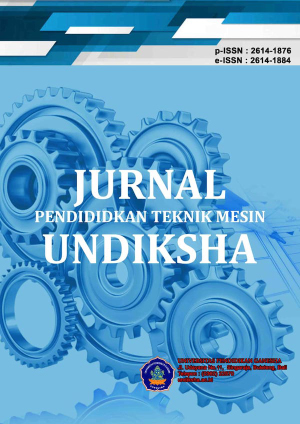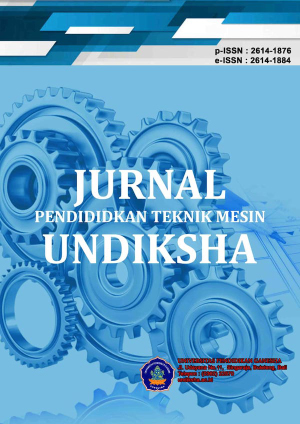Optimasi Waktu Fermentasi Produksi Bioetanol dari Sabut Kelapa Muda Melalui Distilator Refluks
DOI:
https://doi.org/10.23887/jptm.v9i2.39002Abstract
Es kelapa muda merupakan salah satu minuman legendaris yang berasal dari Indonesia, pada produksi es kelapa muda tentunya akan banyak sabut kelapa yang dihasilkan, biasanya penujual es kelapa muda menumpuknya ditepi jalan tempat mereka berjualan, setelah terkumpul banyak biasanya mereka menggunakannya untuk bahan bakar memasak atau dibiarkan begitu saja dan pada akhirnya dibakar. Salah satu cara untuk menanggulangi sampah yang berasal dari produksi es degan ini adalah mengolahnya menjadi suatu hal yang berdaya guna dan dapat meningkatkan daya jual sabut kelapa yang berasal dari limbah penjualan es kelapa muda. Salah satu solusinya adalah dimanfaatkan sebagai bahan baku untuk pembuatan bioethanol. Pembuatan bioethanol pada penelitian ini adalah dengan memanfaatkan sabut kelapa yang dihaluskan dan difermentasi melalui beberapa fariabel untuk waktu menggunakan fariabel 7 hari, 14 hari, 21 hari dan 28 hari sedangkan untuk fariabel campuran bahan fermentasinya terdapat 3 fariabel yaitu fariabel A,B, dan C, untuk selanjutnya dilakukan produksi bioethanol melalui distilasi refluks, dalam hal ini dilakukan dua kali pengulangan distilasi pada setiap sampelnya, setelah bioethanol dihasilkan maka akan dicari pengaruh lama fermentasi terhadap kandungan alkohol.
Kata kunci: Alkohol; Bioetanol; Distilasi; Fermentasi
Young coconut ice is one of the legendary drinks originating from Indonesia, in the production from this ofcourse there will be a lot of coconut coir produced, usually the sellers of young coconut ice pile it on the side of the road where they sell, after collecting a lot, they usually ise it for cooking fuel or leave it alone and eventually burn it. One way to deal with waste originating from ice production is to process it into something that is efficient and can increase the selling power of coconut coir from the sale of young coconut ice. One solution is to use it as raw material for the manufacture of bioethanol. The manufacture of bioethanol in this study is by utilizing mashed and fermented coconut coir through several variables for the time of using the variables 7 day, 14 days, 21 days and 28 days while for the variable mixture of fermented materials there are 3 variables, namely variable A, B, and C. Bioethanol production is carried out through reflux distillation, in this case, two repetitions of distillation are carried out on each sample, after bioethanol is produced it will look for the effect of fermentation time on alcohol content.
Keywords : Alcohol; Bioethanol; distillation; Fermentation.
DAFTAR RUJUKAN
Anisah, D. (2014). Pemanfaatan Sampah Sayuran Sebagai Bahan Baku Pembuatan Bioetanol.. Koncersi. 3;113-18
Akanksha K, Sukumaran, R., K, Pandey A, Rao S.S., Binod, P.(2016). Material balance studies for the conversion of sorghum stover to bioethanol. Biomass dan Bioenergy. 85: 48-52
Arif, A.B., Budiyanto, A., Diyono, W., Hayuningtyas, M., Marwati, T., & Richana, N. (2016). Pengaruh konsentrasi NaOH dan enzim selulase:xilanase terhadap produksi bioetanol dari tongkol jagung. J. Penelit. Pascapanen Pertan. 13(3): 107-114.
Arif, A. B., Diyono, W., Budiyanto, A., & Richana, N. (2016). Analisis rancangan faktorial tiga faktor untuk optimalisasi produksi bioetanol dari molases tebu. J. Informatika Pertan. ; 25(1):145-154
Arif, B. A. (2017). Optimasi Waktu Fermentasi Produksi Bioetanol Dari Dedak Sorghum Manis (Sorghum Bicolor L) Melalui Proses Enzimatis. Jurnal PenelitianPasca Panen Pertanian. 14;2;67-78
Arnata, I.W., Setyaningsih, D., & Richana, N., (2015). Produksi bioetanol dari hidrolisat asam tepung ubi kayu dengan kultur campuran Trichoderma viride dan Saccharomyces cereviceae. Agritech. 35(4): 396-405
Derriyansyah, I. (2018). Analisa Kualitas Bioetanol Sampah Buah Dan Sayur Menggunakan Distilator Model Refluk Sebagai Bahan Bakar. Skripsi. UNP Kediri.
Endah, R.D., Sperisa, D., Adrian, N., & Paryanto. (2007). Pengaruh Kondisi Fermentasi Terhadap Yield Etanol Pada Pembuatan Bioetanol Dari Pati Garut.gema teknik, No. 2
Fattimura, M. (2014). Tinjauan Teoritis Faktor-Faktor Yang Mempengaruhi Operasi Pada Kolom Destilasi. Jurnal Media Teknik. 11;1;23-31
Ferdaus, F. (2008). Pengaruh pH, Konsentrasi Substrat, Penambahan Kalsium Karbonat Dan Waktu Fermentasi Terhadap Perolehan Asam Laktat Dari Kulit Pisang. Widya Teknik. 7; 1; 1-14
Kusumo, F., & Milano, J. (2017). Optimization of bioethanol production from sorghum grains using artificial neural networks integrated with ant colony. Industrial Crops and Products. 97 : 146-155
Nkomba, E.Y., Resburg, E.V., Chimpango A. F. A., Gorgens, J. F. (2016). The influence of sorghum grain decortications on bioethanol production and quality of the distillers dried grain with soluble using cold and conventional warm starch processing. Bioresource Technology.203: 181-189.
Phukoetphim, N., Salakkam, A., Laopaiboon, P., Laopaiboon, L.(2017) Improvement of ethanol production from sweet sorghum juice under batch and fed batch fermentations: effects of sugar levels, nitrogen supplementation and feeding regimes. Elektron. J. of Biotechnol.26: 84-92.
Schlafle, S., Senn T, Gschwind, P,, Kohlus, R. (2017). Feasibility and energetic evaluation of air stripping for bioethanol production. Bioresource Technology.109-115.
Sebayang, A. H., Masjuki, H. H., Ong, H. C., Dharma, S., Silitonga, A. S., Mahlia, T. M. I., Aditiya, H. B. (2016). A perspective on bioethanol production from biomass asalternative fuel for spark ignition engine. RSC Advances.6: 14964–14992.
Siregar, M. (1988). Dasar-Dasar Kimia Organik. Jakarta : Departemen Pendidikan Dan Kebudayaan, Direktorat Jendral Pendidikan Tinggi Proyek Pengembangan Lembaga Pendidikan Tenaga Kependidikan Jakarta.
Wood, I. P., Cook, N. M., Wilson, D. R., Ryden, P., Robertson, J. A., & Waldron, K. W. (2016). Ethanol from a biorefinery waste stream: saccharification of amylase, protease and xylanase treated wheat bran. Food Chemistry.198: 125-131
Zabed, H., Sahu, J. N., Suely, H., Boyce, A. N., & Faruq, G. (2017). Bioethanol production from renewable sources: current perspefctives and technological progress. Renewable and Sustainable Energy Reviews. 71: 475-501
Zhang, K., Zheng, G., Saul, K., Jiao, Y., & Xin, Z. (2017). Evaluation of the multi seeded (msd) mutant of sorghum for ethanol production. Industrial Crops and Product. 97 : 345- 353
Downloads
Published
Issue
Section
License

Jurnal Pendidikan Teknik Mesin Undiksha is licensed under a Creative Commons Attribution-ShareAlike 4.0 International License.










